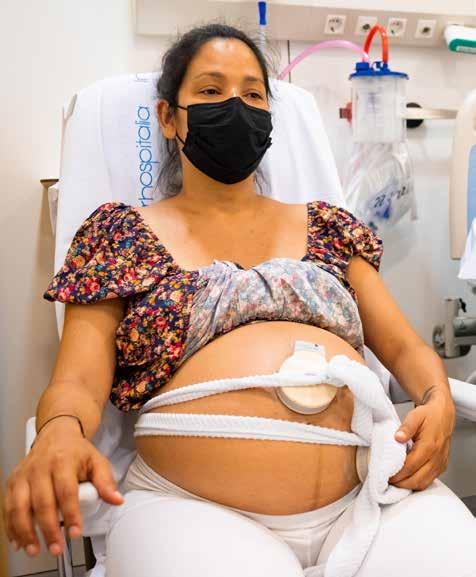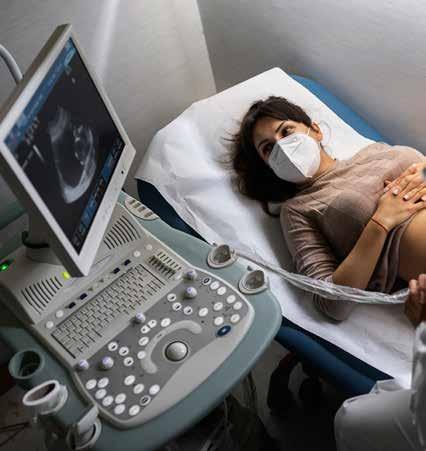Reversing the Risk
Innovative solutions are needed to curb the high rate of pregnancy-related deaths—especially among women of color.
By Sarah Fister Gale
Approximately 700 women die each year because of pregnancy-related complications, according to the U.S. Department of Health and Human Services (HHS).
“Women in the U.S. are more likely to die in pregnancy, during childbirth and postpartum than in any other high-income country,” says Dr. Laurie Zephyrin, vice president for Advancing Health Equity at The Commonwealth Fund. The most common causes of death include infection, blood clots, severe postpartum bleeding, high blood pressure, stroke and cardiac conditions.
To confront this grim reality, payers and providers are rethinking how they can advance the quality of maternal health care before, during and after pregnancy. From educational tools to outreach programs and incentives, they’re successfully providing handson care to low-income women and women of color. Meanwhile, policymakers are examining ways to
expand insurance coverage so that mothers have access to care long after childbirth.
The call to action is critical: about 60% of maternal deaths could have been prevented, according to the Center for Disesase Control and Prevention (CDC). Improving outcomes in maternal health requires increasing support and education for mothers during every step of their pregnancy and postpartum journey through programs deployed locally, statewide and nationally.
Identify Root Causes
Pregnancy-related death is associated with myriad failings in the health care system, including limited access to appropriate care, missed or delayed diagnoses, and lack of knowledge among patients and providers around warning signs, according to the CDC.

The U.S. has the highest maternal mortality rate among developed nations —a dismaying distinction that disproportionately affects women of color.
Women of color bear the brunt of these risks. Dr. Zephyrin notes that Black women are two to three times more likely to die in childbirth than others—a disparity that has been constant since the U.S. started collecting data on maternal mortality rates more than 100 years ago.

“Education is typically protective in health, but in this case it is not,” Dr. Zephyrin says. Black women with college degrees face a 60% higher risk of a maternal death than white or Hispanic women who didn’t graduate high school, according to The Commonwealth Fund.
The data is a stark reflection of entrenched racial inequities in the U.S. health care system and the general lack of investment in maternal health care, says Eugene Declercq, PhD, professor of community health sciences at Boston University School of Public Health. “The system is set up to care for the babies, not the mothers,” he says.
Establish Standards of Care
Historically, there have not been standard approaches in obstetric medicine to identify and respond to maternal health risks, says Christine Morton, PhD, a medical sociologist with the California Maternal Quality Care Collaborative (CMQCC). Each hospital would have its own methods for identifying and addressing potential health events, as would each physician. The lack of standard protocols meant that when a pregnancy-related complication occurred, neither hospitals nor physicians were ready to respond with timely and appropriate treatment, putting women at risk for severe morbidity or even death
To better respond to the top causes of preventable deaths among pregnant and postpartum women, CMQCC created a series of Maternal Quality Improvement Toolkits with funding from the California Department of Health. The toolkits provide a compendium of tools and best practices, care guidelines, hospital-level implementation guides and professional education slide sets. Each addresses different condi-
About 60% of maternal deaths could have been prevented through programs and support efforts deployed locally, statewide and nationally.
Race a Factor in Pregnancy Risk
Women of color face the greatest risk of maternal mortality in the U.S. The maternal death ratio for Black women is 37.1 per 100,000 pregnancies. That is:
3 times the ratio for white women (13.4)
3.5 times the ratio for Hispanic women (11.6)
Among women over the age of 30, pregnancy-related deaths are:

4 to 5 times more common among Black and American Indian and Alaska Native women than white women.
Hemorrhage is the leading cause of maternal-related death among Asian Pacific Islanders, American Indians and Alaska Natives, occurring at twice the rate than for white and Black women.
Cardiomyopathy accounts for 1 in 7 deaths among Black, American Indian and Alaska Native pregnant women.
Sources: The Centers for Disease Control and Prevention, The Commonwealth Fund
tions, including hemorrhage, preeclampsia, sepsis and cesarean section.
Such a comprehensive guide is critical, Dr. Morton says, because each maternal health crisis requires a specific response. The toolkits give health care professionals guidance to make the best choices for their patients in emergency situations. “It’s a free, opensource solution designed to provide consistent quality of care to women across the nation,” she says.
But being trained to identify maternal health risks isn’t enough. Medical professionals also need training on how to overcome their own unconscious bias, says Dr. Lily Higgins, market chief medical officer for Keystone First, part of the AmeriHealth Caritas Family of Companies, and AmeriHealth Caritas Pennsylvania.
“We have to provide more training on implicit bias to providers and their staff, and to encourage providers to hire from the local community,” she says.
Having a diverse and inclusive staff can help make all patients feel welcomed, giving them the confidence that their needs will be addressed.
Improve Outreach Efforts
Along with more consistent prenatal and postnatal care, most experts believe there’s a need for programs designed to holistically support women throughout their pregnancy and postpartum experience. For instance, there’s a growing movement among community groups to ensure women have access to doulas, who provide emotional support and advocacy, and to midwives, who can provide clinical pregnancy care at home or in a medical facility.


The Birth Sisters program at Boston Medical Center, for example, provides a doula service to support lowincome women who are at risk of complications during pregnancy, childbirth and the postpartum period. “The doulas, who are from the communities they serve, help women navigate the health care system, and provide education and knowledge,” Dr. Declercq says.
The doulas and midwives provide care every step of the way, educating women on their prenatal health needs, helping them through childbirth and assisting them at home after birth. The program has led to a decrease in C-section deliveries, which often lead to complications, and to an increase in the number of breastfeeding mothers.
It’s also important for Medicaid providers to proactively meet their members’ needs through outreach efforts, says Dr. Higgins. Her group’s Bright Start® program hosts baby showers that target mothers who
live in at-risk communities and provides health and wellness education, support and incentives for women to access care throughout their pregnancies. The program sends reminders about appointments, offers access to transportation, and delivers gift cards and a crib to members who attend most of their prenatal appointments. “The program is designed to encourage members to seek care and to follow prenatal protocols,” Dr. Higgins says.
If a woman stops going to appointments, the Bright Start team reaches out directly to help her get back on track with her care. “It’s a way for us to be sure moms have the care they need,” Dr. Higgins says.
Through related programs, Dr. Higgins’ group helps members in low-income communities work with dieticians to provide kitchen tools and teach women healthy shopping and cooking techniques. The programs also provide women with blood pressure cuffs to monitor heart health—a simple and costeffective way to help detect cardiovascular issues or preeclampsia before they create serious risks, Dr. Higgins says. “If they see their blood pressure increasing, they know to seek care.”
These community programs help women get care that might otherwise elude them, particularly among African Americans. “It’s a population where we have seen the highest rates of improvement,” Dr. Higgins says.
“The system is set up to care for the babies, not the mothers.”
Expand Postpartum Coverage
Postpartum care is critical in preventing maternal deaths. “Most people think of maternal mortality as an event that happens during childbirth,” Dr. Declercq says.

Mothers also need monitoring in the year following birth. Only 17% of maternal deaths occur the day of delivery. More than half (52%) of deaths occur during the 12 months postpartum, according to The Commonwealth Fund. Of those deaths, 19% occur one to six days postpartum, 21% occur between one and six weeks postpartum and 12% occur during the remainder of the year.
But there’s a huge gap: Medicaid, which covers 45% of U.S. births and 66% of births to Black mothers, generally cuts maternal postpartum coverage after 60 days. “A significant number of women don’t have the resources to get preventive care after those 60 days,” Dr. Declercq says.
One stopgap to provide care is a provision in the American Rescue Plan Act of 2021 to give states the option to offer a Postpartum Extension of Coverage to 12 months via a state plan amendment. The extension began April 1, 2022.
The Congressional Budget Office estimates the extended coverage will cost the federal government
Only 17% of maternal deaths occur the day of delivery. More than half (52%) of deaths occur during the 12 months postpartum.
more than $6 billion in the first 10 years. It also will add more costs for participating states, since the provision doesn’t change the federal matching level for Medicaid payments, which ranges from 56.2% to 84.5%. Twenty-eight states and the District of Columbia have implemented a 12-month extension for postpartum coverage, according to the Kaiser Family Foundation. These states include Alabama, California, Connecticut, Florida, Georgia, Hawaii, Illinois, Indiana, Kansas, Kentucky, Louisiana, Maine, Maryland, Massachusetts, Michigan, Minnesota, New Jersey, New Mexico, North Carolina, North Dakota, Ohio, Oregon, Pennsylvania, South Carolina, Tennessee, Virginia, Washington, and West Virginia.
Separately, six states are planning to implement a 12-month extension on postpartum coverage: Arizona, Colorado, Delaware, New York, Rhode Island, and Vermont.
Both Wisconsin and Texas have proposed limited coverage extensions.
Dr. Declercq believes the biggest boost for maternal health could come from providing universal health care. By enabling all women to get appropriate care before, during and after childbirth, this solution would address many of the problems that contribute to maternal risk and mortality. “Almost every other industrialized country offers universal care,” he says.
Measure Success
Whatever the solution, the need for more accurate data remains—and that requires better collection, monitoring and analysis of results. For instance, no consistent data-collection process yet exists to count how many women die because of pregnancy, according to Dr. Declercq. Instead, he says states use different methods to determine if a woman’s death was pregnancy related, creating potential inconsistencies and errors that skew results.
Having clear data for mortality rates and the impact of outreach programs will allow health care providers to identify strategies that deliver the biggest benefits for women, children and the systems that support their care, Dr. Declercq says. That data can help payers, providers and community organizations make the best choices on behalf of pregnant women and new mothers.
“We need large structural changes that address the unequal access to care and coverage,” Dr. Morton says. “It’s an issue of human rights that must be addressed.”
Action Plan
As part of a plan to improve maternal health outcomes, the U.S. Department of Health and Human Services (HHS) set three targets to reach by 2025:

§ Reduce the maternal mortality rate by 50%.
§ Reduce low-risk cesarean deliveries by 25%.
§ Achieve blood pressure control in 80% of women of reproductive age with hypertension.
To achieve these results, HHS plans to:
§ Improve prevention of and treatment for cardiovascular disease.
§ Tie provider payment to positive outcomes, such as reducing C-sections.
§ Expand evidence-based clinical best practices.
§ Improve access to prenatal and postpartum care for at-risk populations.
§ Improve infant health outcomes by supporting parent-child relationships.
§ Advance research to identify effective best practices.
